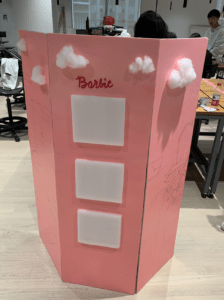Formulating an Idea
As per the directions for the Interaction Lab group project, when creating the BarbieAI, the artifact had to be a completely non-mechanical artifact that through performance and prop work would allude to an interactive object based on one of 3 dystopian short stories. To determine what the artifact would be, a group brainstorming session occurred where every group member shared their best ideas that were previously created in the “Reading” part of the group project assignment. The reading portion involved all group members to come up with an invention that could exist in the fictional world of “The Veldt” by Ray Bradbury, “The Ones Who Walk Away from Omelas” by Ursula K. Le Guin, and “The Plague” by Yan Leisheng. In the end, a combination of ideas (a Barbie dream house inspired by the Happylife home from “The Veldt”, and a conflict resolution mediating machine also inspired by “The Veldt”) were turned into a “Barbie” closet that could automatically choose your outfits.
Before designing the artifact, we answered questions that helped us figure how the artifact was to be used and how it would interactive. This can be seen in the link below.
While none of my ideas were selected when deciding what our artifact should be. I was an avid participator in coming up with these “guiding questions”, as well as brainstorming answers to these questions. My contributions along with the contributions of every other group member gave us a clear views of the artifact we would create.
Building BarbieAI
The final idea for BarbieAI is an interactive closet that senses your body biometrics, mood, and outside weather using a mixture of visual and temperature sensors to determine a “perfect” outfit based on current fashion trends. The closet then generates these clothes to be worn.
Using a cardboard box that was cut into the shape of a bent poster board as a base, plastic poster board was painted pink and hot glued to each side of the box to make a rhomboidal front facing structure. Then the closet was decorated to add extra detail. After the team collaborated on deciding the shape of the closet, I took the main role in building it. Cutting out the pink panels and gluing them to the cardboard base, decorating the closet with clouds, adding the barbie logo, and drawing on the side details were all done by me and the help of a rotating cast of my other teammates.

the overall shape is reminiscent of a changing stall and thus was not too difficult to make and stay together. The most difficult part was creating a “Barbie” pink color to pain the closet, and then cutting out the panels to attach them to the cardboard base. A pleasant surprise was that the the closet was quite sturdy and had no problems standing on its own, and stayed together strong when being transported.
Video of performance is embedded below:
I think the performance was successful in delivering information on how the product was interactive, as well as exploring some social impact that would be involved in the invention of such an artifact as the BarbieAI. However, I think that came at the cost of making our presentation truly a great narrative. Much of the dialogue could be strewn to be almost advertisement-like. In possible further iterations I believe that a more subtlety approach would improve the project. I also believe that including more of the social problems that we had discussed possible with this artifact into our presentation would have made our presentation stronger. However I believe, terms of explaining its interactivity based on my definition of interaction, the performance was very successful. My definition of interaction is that both parties are able to receive stimulus from the other and process in into a reaction. The human inputs their tastes and emotions and the machine is able to make a physical object out of that action, and then the human can react to the physical object letting the closet to continue to react.
Overall the group got a long quite well, and everyone in the group was able to contribute to an aspect of its success. There was no storming phase and pretty immediately we were working productively as a team. This was especially the case in the brainstorming phase. Everyone was present during the building of the object. And although lopsided, everyone has a role in the performances. I would say this is a success considering the group had 7 people.
The Mirror
Another groups performance I particularly enjoyed was Groups E’s “The Mirror”. I think it is so successful for 3 reasons. One, their artifact was directly based in the world of on of the short stories quite directly. Two, their artifact and performance directly look at the social ramifications of their object. The mirror is a conversation piece in the work of the story that reveals and commentates on the social ills of the fictional city of Omelas. The third reason I think it was successful is that all of that was conversed quite seamlessly in their performance and was not like an infomercial at all.
One way they might not have been entirely successful is that I do not think the artifact was completely interactive. While the mirror could react to the stimulus of whoever was looking into it, a person could not continue a “conversation” with it, as its possible outcomes were quite simple (look into the mirror when you are happy? see the abused child. Look into the mirror sad? you will see nothing). However, I think it was clever because it seemed the purpose of the mirror was to foster interaction and conversation between the citizens of Omelas.
End
This is the end of my blog post regarding the Interaction Lab group project. Thank you for reading
-Vilius Schmidt 9/27/2023